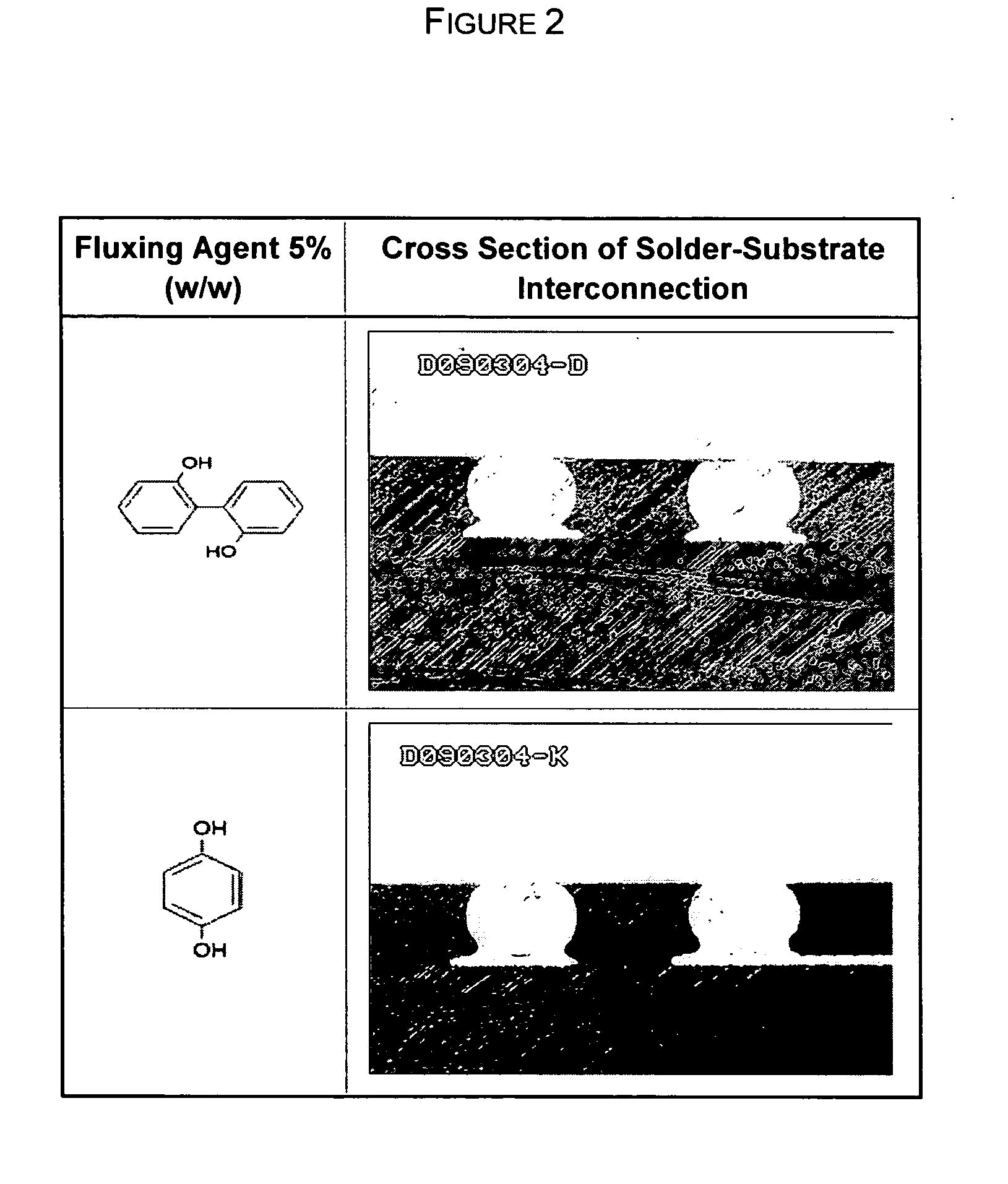Fluxing compositions
a composition and composition technology, applied in the direction of soldering apparatus, semiconductor/solid-state device details, manufacturing tools, etc., can solve the problems of failure of semiconductor packages, corrosion of semiconductor packages, and inconvenient chemistries of anhydride-based fluxing agents
- Summary
- Abstract
- Description
- Claims
- Application Information
AI Technical Summary
Benefits of technology
Problems solved by technology
Method used
Image
Examples
example 1
[0032] In this example, various compounds were tested for performance as fluxes applied directly to solder, as would be done prior to a capillary flow operation. Performance was measured as the time in seconds it took for the fluxing agent to collapse a solder ball. Copper or gold-plated copper coupons were used as substrates and the solder was a lead-free Sn95.5Cu3.8Ag0.7 solder having a melting point of 217° C. (The melting point of the solder will vary depending on the actual metallurgy.) The substrate coupons were preheated on a hot plate to 240° C. (a temperature higher than the melting point of the solder), five to ten mg of fluxing agent were dropped onto the heated hot plate, and then four to six granules of solder, enough to make a solder ball, were dropped onto the fluxing agent. When a solder ball starts to flux, it rapidly collapses and merges into a solder glob that displays a shiny surface. This reaction was observed on all the examples tested and the time elapsed befo...
example 2
No-Flow Fluxing Compositions
[0033] In this Example, fluxing agents were tested in no-flow fluxing underfill compositions. Assemblies of a solder bumped die and substrate were prepared using a thermal compression Toray Bonder to establish electrical interconnections between the bumped die and the substrates. The fluxing compositions were dispensed onto a BT substrate covered by solder mask with the exposed traces being Ni / Au plated onto Cu. A silicon die (5×5 mm) bumped with Sn95.5Cu3.8Ag0.7 solder bumps was aligned with the exposed traces on the substrate. The substrate was heated to 80° C. and the die and substrate contacted with pressure of 20 Newtons in the thermal compression bonder. The die was then heated in ramped profile from 200° C. to 220° C. within 1-2 seconds and held at 220° C. for 5-6 seconds to form an assembly of silicon die and substrate. The electric connections of the solder joints were confirmed by measuring the resistance across the circuits using an Agilent 34...
example 3
Capillary Flow Underfill. Eutectic Solder.
[0046] Two BT substrates covered by solder mask with the exposed traces being Ni / Au plated onto Cu and two 10×10 mm silicon dies bumped with eutectic solder Pb63Sn37, were brushed with fluxing agents prior to solder reflow and capillary flow underfill operations as described in the Background section of this specification. One set of parts was brushed with a commercial fluxing agent sold by Kester as product number 6502. The other set was brushed with a fluxing agent comprising a solution of 3-hydroxy-2-methyl-4-pyrone
tripropylene glycol (3% w / w). The parts were dried in air and the die bonded to the substrate using a GSM Flipchip die bonder. The electric connections of the solder joints were confirmed by measuring the resistance across the circuits using an Agilent 34401 Digit Multimeter. The capillary flow underfill, which was a proprietary composition comprising a cyanate ester resin, was dispensed along the edge of the die and allowe...
PUM
 Login to View More
Login to View More Abstract
Description
Claims
Application Information
 Login to View More
Login to View More - R&D
- Intellectual Property
- Life Sciences
- Materials
- Tech Scout
- Unparalleled Data Quality
- Higher Quality Content
- 60% Fewer Hallucinations
Browse by: Latest US Patents, China's latest patents, Technical Efficacy Thesaurus, Application Domain, Technology Topic, Popular Technical Reports.
© 2025 PatSnap. All rights reserved.Legal|Privacy policy|Modern Slavery Act Transparency Statement|Sitemap|About US| Contact US: help@patsnap.com



